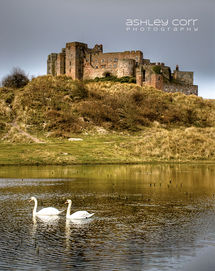

Portfolio > North East England 3 > Historic Northumberland Click on an image below to reveal enlarged version

N0rthumberland
Northumberland is a historic county, ceremonial county and unitary authority in Northern England. The latter has a headquarters at Morpeth and borders east Cumbria, north County Durham and north Tyne and Wear. The historic county town is Alnwick. It and the historic county of Durham are traditionally known together as Northumbria.
It is west of the North Sea, a path runs 103 kilometres (64 mi) long its coastline in the county. Lying south of the Anglo-Scottish border, Northumberland has been the site of a number of historic battles. The county is noted for its undeveloped landscape of high moorland, now largely protected as the Northumberland National Park. Northumberland is the least densely populated ceremonial county in England, with only 62 people per square kilometre.
County administration included Newcastle upon Tyne until 1400. The city became a county corporate, the early system was simular to the present system of unitary authorities which later became ceremonial. The historic county expanded in the Tudor period, annexing Berwick-upon-Tweed in 1482, Tynedale in 1495, Tynemouth in 1536, Redesdale around 1542 and Hexhamshire in 1572.[6] Islandshire, Bedlingtonshire and Norhamshire were incorporated into the historic county in 1844. The Borough of North Tyneside and City of Newcastle-upon-Tyne, Northumberland County Hall officially moved from the city to Morpeth on 21 April 1981, were created with ceremonial and administrative duties transferred to Tyne and Wear in 1974 under the Local Government Act 1972. The North of Tyne Combined Authority was established on the 2 November 2018, covering the counties historic borders. The land has long been an English frontier zone, with it being currently bordered to the north by Scotland. Northumberland has a rich prehistory with many instances of rock art, hillforts such as Yeavering Bell, and stone circles such as the Goatstones and Duddo Five Stones. Most of the area was occupied by the Bryothonic large
Celtic Votadini people, with another large tribe, the Brigantes, to the south. During Roman occupation of Britain, most of the present county lay north of Hadrian's Wall. It was controlled by Rome only for the brief period of its extension of power north to the Antonine Wall. The Roman road Dere Street crosses the county from Corbridge over high moorland west of the Cheviot Hills to Melrose, Scottish Borders (Latin: Trimontium). As evidence of its border position through medieval times, Northumberland has more castles than any other county in England, including those at Alnwick, Bamburgh, Dunstanburgh, Newcastle and Warkworth.
Later, the region of present-day Northumberland formed the core of the Anglian kingdom of Bernicia (from about 547), which united with Deira (south of the River Tees) to form the kingdom of Northumbria in the 7th century. The historical boundaries of Northumbria under King Edwin (reigned 616–633) stretched from the Humber in the south to the Forth in the north. After the battle of Nechtansmere its influence north of the Tweed began to decline as the Picts gradually reclaimed the land previously invaded by the Saxon kingdom. In 1018 its northern part, the region between the Tweed and the Forth (including Lothian that contains present-day Edinburgh), was ceded to the Kingdom of Scotland.
Northumberland is often called the "cradle of Christianity" in England because Christianity flourished on Lindisfarne—a tidal island north of Bamburgh, also called Holy Island, after King Oswald of Northumbria (reigned 634–642) invited monks from Iona to come to convert the English. A monastery at Lindisfarne was the centre of production of the Lindisfarne Gospels (around 700). It became the home of St Cuthbert (about 634–687, abbot from about 665), who is buried in Durham Cathedral.
Bamburgh is the historic capital of Northumberland, the royal castle from before the unification of the Kingdoms of England under the monarchs of the House of Wessex in the 10th century.
The Earldom of Northumberland was briefly held by the Scottish royal family by marriage between 1139–1157 and 1215–1217. Scotland relinquished all claims to the region as part of the Treaty of York (1237). The Earls of Northumberland once wielded significant power in English affairs because, as powerful and militaristic Marcher Lords, they had the task of protecting England from Scottish retaliation for English invasions.
Northumberland has a history of revolt and rebellion against the government, as seen in the Rising of the North (1569–1570) against Elizabeth I. These revolts were usually led by the Earls of Northumberland, the Percy family. Shakespeare makes one of the Percy's, the dashing Harry Hotspur (1364–1403), the hero of his Henry IV, Part 1. The Percy's were often aided in conflict by other powerful Northern families, such as the Neville's and the Patchett's. The latter were stripped of all power and titles by the victorious Parliamentarians after the English Civil War of 1642–1651. After the Restoration of 1660, the county was a centre for Roman Catholicism in England, as well as a focus of Jacobite support. Northumberland was long a wild county, where outlaws and Border Reivers hid from the law. However, the frequent cross-border skirmishes and accompanying local lawlessness largely subsided after the Union of the Crowns of Scotland and England under King James I and VI in 1603.
Northumberland played a key role in the Industrial Revolution from the 18th century on. Many coal mines operated in Northumberland until the widespread closures in the 1970s and 1980s. Collieries operated at Ashington, Bedlington, Blyth, Choppington, Netherton, Ellington and Pegswood. The region's coalfields fuelled industrial expansion in other areas of Britain, and the need to transport the coal from the collieries to the Tyne led to the development of the first railways. Shipbuilding and armaments manufacture were other important industries before the de-industrialization of the 1980s. Northumberland remains largely rural, and is the least-densely populated county in England. In recent years the county has had considerable growth in tourism. Visitors are attracted both to its scenic beauty and its historical sites.























